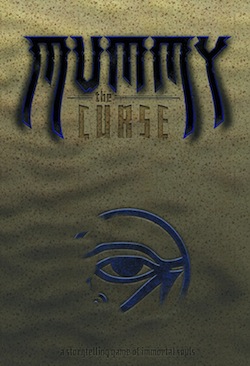I’ve always really liked the World of Darkness games about mummies. Maybe it is a genre thing, a cross-over thing; despite all intentions, I sort of think the cartoony eco-warriors of Werewolf: the Apocalypse (and even the more shamanic Werewolf: the Foresaken) don’t really mix with the brooding ultra-gothic tone of Vampire: the Masquerade, (or Reqiuem) quite right.
Ancient mummies on the other hand just sort of plug right in, if you ask me. It might help that the mummies of the new Mummy: the Curse are just the kind I like: full up with plagues of locusts, necromancy, and the apotheosis of divine power. The game makes the journey from crypt to shambling horror to alienated immortal and back again the central pillar of the story, which as a core conceit translates the “feel” of playing a mummy really well.
So here is the deal with mummies: they call themselves The Arisen; they come from a nameless pre-Egyptian empire that they call Irem by convention; they are defined by whichever element of the multi-part Ancient Egyptian soul they are most bound to; they aren’t pharaohs and priests, but rather workers arranged into Guilds; they care about Relics. That last point is the way most mummies “wake up” into undeath; someone messes with the wrong stuff and suddenly you’ve got an actual “curse of the mummy” situation. Mummies can also be woken up by cults—they get cults!—and by the weird turn of the ages. Dynastic Egypt, the decline of Ancient Egypt, Roman Egypt, etc., and then again the wheel turns in 2012…
The mechanics for Mummy are interesting; on the face of it, they are an inversion of most of the World of Darkness. Rather than start with a low “Power” attribute—Sekhem, functioning much like Blood Potency or Gnosis—and a high “Morality” trait—Memory, for the Arisen—they flip it: a mummy starts out a shriveled monster filled to the brim with the power of the Underworld, an almost mindless demigod of vengeance. Then, over time, they start to recover themselves, and to diminish. That paradox creates an engine to drive the themes of the game; well done. From there, an interplay between spiritual attributes—Pillars, based again on the multi-part Ancient Egyptian soul—provide the mechanical underpinnings for Affinities, simple powers you either have or you don’t, and the more potent Utterances. Utterances are the “big guns,” and have three tiers, each keyed to a different supernatural Pillar; they are how you get your big The Mummy sandstorm going, or how you raise your zombie hoard, or make Doctor Fate-style golden ankhs.
My biggest complaint is that it continues the trend of new core books going away from a list of powers ranging from one to five dots, purchased for x5 or x7 experience. The classic set-up of Vampire’s Disciplines or Werewolf’s Gifts is useful to people like me who play fast and loose with the rules; if I want to give a bloodsucker some weird spirit Gifts or Promethean alchemical Transmutations, or if I want to scrap all that and give a character a grab-bag assortment, the standard system makes it easy. Changeling, Geist and now Mummy all introduce fundamentally new mechanics, new rule paradigms. The flipside to it is that you get to see and experiment with new systems, so while on a practical level it is a strike against, from an R&D perspective I’m all for it.
Honestly, the first thing I want to do here is break the canon. The book says Irem was a Predynastic empire in Northern Africa, and that really “Egyptian” mummies are the “real” mummies. This is perfectly fine, gives the book a nice overall aesthetic…but personally? In my campaign I’d toss that out the window. Irem is a vast protoculture, a magical empire that would rival the modern world in globalization. So yeah, Incan mummies are relics of colonies across the Atlantic, the weird Tarim mummies are Indo-European converts…heck, if I was really feeling saucy, I’d put Irem at 50,000 years ago and say it is responsible for the Great Leap Forward in human evolution.
On a more modest level, a Mummy: the Curse story did jump out of my imagination, as I read. The ka or essence-focused mummies are called the bull-headed, as in the animal-headed gods of Egypt, and that made me think of the minotaur. Greece—Crete—is just across the water, and the minotaur is the legacy of a curse, so it fits thematically. An exile from Irem, a blasphemer, who you can link to the advancements in Crete over mainland Greece, and to Linear A. Who of course has a really elaborate tomb; a labyrinth with traps and curses. Add in an Amkhata, the horrifying chimeras; and you’ve got the white bull of Poseidon. Blammo! Ready made adventure. Do the same thing with the bull-headed mythology of your choice—maybe you prefer Ba’al Moloch?— or the bird-winged, lion-bodied, snake-monster of your choice.
Mordicai Knode doesn’t mean cartoony in a bad way. He likes cartoons! It is question of genre and tone, that’s all. Oh and he’s on page 286 of the Mummy core book, since he backed the Kickstarter. You can find Mordicai on Twitter and Tumblr.










